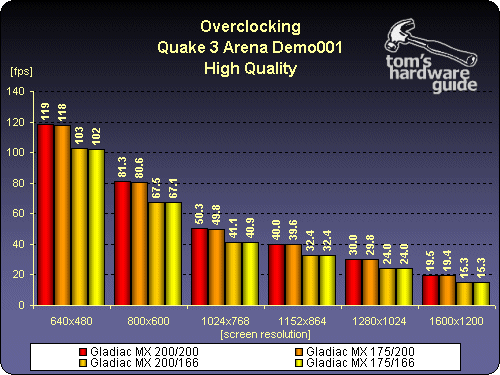ELSA Gladiac MX Review
Performance Conclusion
Clearly the GeForce DDR is the best solution if you want the fastest. I expected more from the Gladiac in our testing as it ended up being a GeForce SDR equivalent. I'm not sure how many people are willing to accept this but at the minor price difference, I'd stick with a GeForce DDR if performance were the biggest criteria for you.
Overclocking
I knew going into this that the memory would be my key to greatly improved performance numbers from the Gladiac. I modified my board with better cooling for the memory but the maximum setting for my board was the same regardless. The setting I ended up with was 200 MHz core and 200 MHz memory (compared to the stock 175 MHz/166 MHz). Obviously, the top setting matched my expectation for visual quality and stability for it to be accepted as valid. I used Quake Arena in High Quality mode to illustrate the benefits from the overclocking.
The results are very clear as we see the core overclocking bought us nearly nothing and the memory boost offering the best gains in performance. I was able to gain over 20% performance in tests by pushing the memory setting up a reasonable amount. I doubt this setting will be a problem for anyone to reach, as the setting is somewhat conservative.
Conclusion
ELSA chose to come to market as soon as they could to capture much of the GF2 MX momentum hoping to cash in on the initial rush of buyers. I think this wasn't the right idea for this type of product as the Gladiac MX stepped into some serious competition now that it has finally been released. The sad part about this is that it is competing with some older siblings that aren't performance slouches and with the recent price reductions, offer great value as well. The factors holding back the Gladiac MX are its price and absence of TwinView right out of the box. I had expected a little more for a little less when these GF2 MX boards surfaced.
My recommendation at this point would be to hold off until prices come down a bit as I can't justify buying a product that offers nothing over a GeForce SDR but costs $30 more. The only saving grace will be the VIVO module for those who fancy the Video-in option. That is about the only thing the GeForce SDR can't offer at that low of a price. The unfortunate thing for ELSA is that this need is in the minority while the majority cares more about visual quality (which is the same between the two) and performance, than anything else.
Get Tom's Hardware's best news and in-depth reviews, straight to your inbox.
